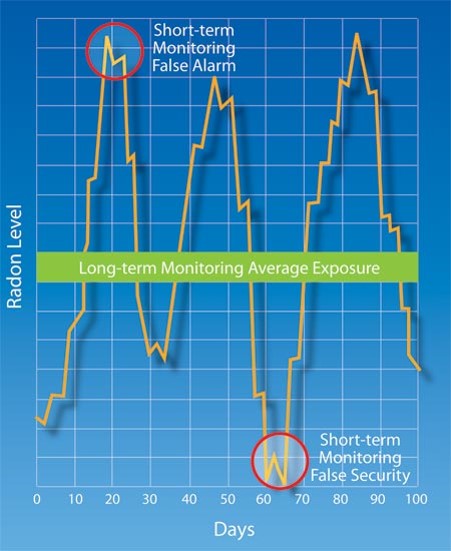Both are reliable detectors for long-term radon measurement and suitable for residential testing. Which is right for you depends on how and when you want to test for radon. We have laid out the differences between our testing devices below, so you can make an informed decision.

Health Canada encourages the use of single-use 90 day tests (called long-term alpha track detectors) that are certified, less expensive, and provide reliable measurement. Health Canada considers Electronic Radon Monitors to be screening tools that can help get a sense of whether or not radon is an issue in your home, and can be a good way to follow-up after a single-use 90 day test (and/or radon reduction). A 90 day test remains the best way to test for radon in your home.
| Single-use 90 Day Test | Electronic Monitor | |
|---|---|---|
| Cost | $65.00 plus tax. | Price ranging from $196.00 to $299.99 plus tax. |
| Reusability | Single use product. Get an average over a period of time of the radon level at a particular location. | Versatile, test multiple locations with the same device or monitor a single location continuously. |
| Electricity requirements | Passive detector, no electricity required. Can be used in places without access to power. | Digital device, must be powered. Some models are battery operated, others are plug-in. |
| Air quality monitoring features | Only measures radon levels in a home. | Some models can measure other indoor air quality features in addition to radon, including humidity, CO2, VOCs, PM 2.5, air pressure, and temperature. |
| Testing process | Detector must be activated on our website. After 90 days* of testing, detector must be mailed to lab for analysis. | Plug and go. Smartphone app required for most models. |
| Receiving results | 90 day test results available via email within 15-20 business days upon return of test to the lab. | Immediate real-time results available within one hour* on device or via smartphone app (model dependent). Access to weekly and monthly averages. |
| Radon measurement | Results provided in Canadian and international standard: Becquerels per cubic metre (Bq/m3). | Results might be provided in US standard by default: picocuries per litre (pCi/L). You may have to edit device settings or convert to Bq/m3 when comparing to Canadian and international guidelines. |
| Financial supports | Many financial supports for radon reduction in Canada require the results use of a 90 day test. | Some will not provide financial support with the results from a Electronic Radon Monitor. |
| Purchase | Single-use 90 Day Test | Electronic Radon Monitor |
| Health Canada recommends testing using a 90 day test to determine if action needs to be taken to reduce levels in your home. | Electronic monitors can be a great way to monitor levels post-mitigation, and some models also feature other indoor air quality measures. |
(* Health Canada recommends that you test for at least 90 days to get a better long-term picture of your radon level before taking action.)
When looking at a digital read-out on an Electronic Monitor, it can be alarming to see a sudden spike in radon levels. It is important for homeowners to understand that while radon levels may occasionally spike upwards or dip downwards, it is the average annual exposure level that is a concern. Health Canada recommends that homeowners base any decision to mitigate their home on a long term average radon level, which is determined by testing for 90 days or more.
$65.00
Price ranging from $196.00 to $299.99
You must activate your test on this website to receive your results.
Upon completion, enter the end date and return radon test for analysis.